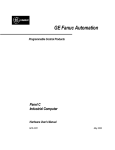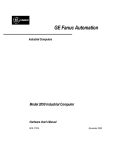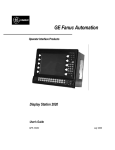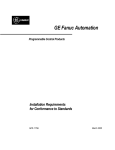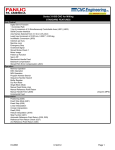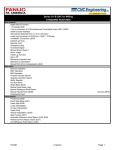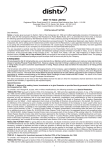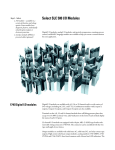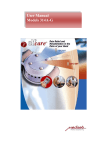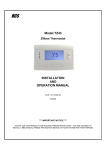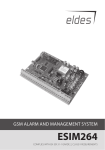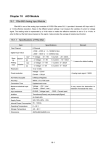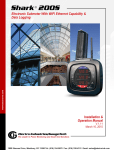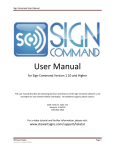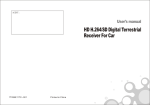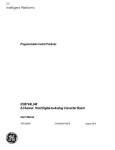Download Panel C Industrial Computer Hardware User`s Manual, GFK
Transcript
GE Intelligent Platforms Programmable Control Products Panel C Industrial Computer Hardware User’s Manual, GFK-2251B May 200 GFL-002 Warnings, Cautions, and Notes as Used in this Publication Warning Warning notices are used in this publication to emphasize that hazardous voltages, currents, temperatures, or other conditions that could cause personal injury exist in this equipment or may be associated with its use. In situations where inattention could cause either personal injury or damage to equipment, a Warning notice is used. Caution Caution notices are used where equipment might be damaged if care is not taken. Note: Notes merely call attention to information that is especially significant to understanding and operating the equipment. This document is based on information available at the time of its publication. While efforts have been made to be accurate, the information contained herein does not purport to cover all details or variations in hardware or software, nor to provide for every possible contingency in connection with installation, operation, or maintenance. Features may be described herein which are not present in all hardware and software systems. GE Intelligent Platforms assumes no obligation of notice to holders of this document with respect to changes subsequently made. GE Intelligent Platforms makes no representation or warranty, expressed, implied, or statutory with respect to, and assumes no responsibility for the accuracy, completeness, sufficiency, or usefulness of the information contained herein. No warranties of merchantability or fitness for purpose shall apply. * indicates a trademark of GE Intelligent Platforms, Inc. and/or its affiliates. All other trademarks are the property of their respective owners. ©Copyright 2010 GE Intelligent Platforms, Inc. All Rights Reserved Contact Information If you purchased this product through an Authorized Channel Partner, please contact the seller directly. General Contact Information Online technical support and GlobalCare http://www.ge-ip.com/support 1H2 Additional information http://www.ge-ip.com/ 3H Solution Provider [email protected] 4H Technical Support If you have technical problems that cannot be resolved with the information in this guide, please contact us by telephone or email, or on the web at www.ge-ip.com/support 5H Americas Online Technical Support www.ge-ip.com/support 6H7 Phone 1-80 International Americas Direct Dial 0-433-2682 1-780-420-2010 (if toll free 800 option is unavailable) Technical Support Email [email protected] 8H9 Customer Care Email Primary language of support [email protected] 10H English Europe, the Middle East, and Africa Online Technical Support www.ge-ip.com/support 12H3 Phone +80 EMEA Direct Dial 0-1-433-2682 +352-26-722-780 (if toll free 800 option is unavailable or if dialing from a mobile telephone) Technical Support Email [email protected] 14H5 Customer Care Email Primary languages of support [email protected] 16H7 English, French, German, Italian, Czech, Spanish Asia Pacific Online Technical Support www.ge-ip.com/support Phone 18H9 +86-400-820-8208 +86-21-3217-4826 (India, Indonesia, and Pakistan) Technical Support Email [email protected] (China) 20H1 [email protected] (Japan) 2H3 [email protected] (remaining Asia customers) 24H5 Customer Care Email [email protected] 26H7 [email protected] (China) 28H Contents Panel C Industrial Computer Features ........................................................................1-1 Feature Summary ............................................................................................................. 1-2 Removable Hard Disk Drive ............................................................................................. 1-3 CD-ROM ........................................................................................................................... 1-3 Front Panel Keypads ........................................................................................................ 1-3 Status LEDs ...................................................................................................................... 1-3 Front Access Panel........................................................................................................... 1-4 I/O Channels ..................................................................................................................... 1-4 Network Interface.............................................................................................................. 1-5 Expansion Slots ................................................................................................................ 1-6 Application Software ......................................................................................................... 1-6 Powerup and Software Installation..............................................................................2-1 Setup................................................................................................................................. 2-1 Initial Startup Procedure........................................................................................... 2-1 Startup for Windows NT Systems ............................................................................ 2-3 Startup for Windows 2000 Systems......................................................................... 2-4 Startup for Windows XP Systems ............................................................................ 2-5 Configuring the Industrial Computer to Run on a Microsoft Network....................... 2-6 Installing Application Software........................................................................................ 2-10 Directory Structure .......................................................................................................... 2-10 Image Recovery.............................................................................................................. 2-11 Shutting Down the Computer.......................................................................................... 2-11 Hardware Installation ....................................................................................................3-1 Warnings for Class 1 Division 2 Approval ........................................................................ 3-1 Installation Guidelines....................................................................................................... 3-2 AC Input Power ........................................................................................................ 3-2 Panel Mounting ........................................................................................................ 3-2 Cutting the Panel Cutout .......................................................................................... 3-2 Installing Panel Mounting Clips................................................................................ 3-3 Installing Expansion Cards ............................................................................................... 3-5 Blanking Plates ........................................................................................................ 3-5 Configuring Expansion Cards (Legacy ISA Only) .................................................... 3-6 Connectors and Cabling ...............................................................................................4-1 Power Input....................................................................................................................... 4-2 Communications Ports...................................................................................................... 4-3 Port Configurations .................................................................................................. 4-3 USB Ports................................................................................................................. 4-3 Compact Flash Port ................................................................................................. 4-3 Mouse and Keyboard Ports...................................................................................... 4-4 GFK-2251B v Contents Floppy Disk Drive and CD-ROM Ports..................................................................... 4-5 Video Output Port..................................................................................................... 4-5 Printer Port LPT1 ..................................................................................................... 4-6 Serial Communication Ports..................................................................................... 4-7 Ethernet Communication Port.................................................................................. 4-8 System Operation..........................................................................................................5-1 System Peripherals........................................................................................................... 5-2 Removable Hard Disk Drive..................................................................................... 5-2 CD-ROM Drive ......................................................................................................... 5-2 Floppy Disk Drive ..................................................................................................... 5-2 External Keyboard and Mouse................................................................................. 5-2 Graphic System........................................................................................................ 5-2 Operator Interfaces ........................................................................................................... 5-3 Keypads ................................................................................................................... 5-3 Communications ............................................................................................................... 5-7 BIOS Settings.................................................................................................................6-1 Diagnostics and Troubleshooting ...............................................................................7-1 Self-Test Diagnostics ........................................................................................................ 7-1 System Test and Initialization ........................................................................................... 7-1 System Configuration Verification..................................................................................... 7-1 Troubleshooting ................................................................................................................ 7-2 Powerup ................................................................................................................... 7-2 Display...................................................................................................................... 7-2 Memory .................................................................................................................... 7-3 External PS/2 Mouse ............................................................................................... 7-3 Keyboard .................................................................................................................. 7-3 Communications ...................................................................................................... 7-4 CMOS Checksum Error .................................................................................................... 7-6 To replace the battery .............................................................................................. 7-6 Technical Data ...............................................................................................................8-1 Monitor System ................................................................................................................. 8-1 Industrial PC ..................................................................................................................... 8-1 Product Agency Approvals, Standards, and General Specifications...................... A-1 Agency Approvals ............................................................................................................. A-1 Note: The agency approvals listed above and on the Declaration of Conformities are believed to be accurate, however, a product’s agency approvals should be verified by the marking on the unit itself.Government Regulations.......................................................... A-1 Government Regulations .................................................................................................. A-2 General Specifications...................................................................................................... A-3 Nonincendive Field Wiring (Control Drawing #DR00) ...................................................... A-4 vi Panel C Industrial Computer Hardware User’s Manual–May 2007 GFK-2251B Chapter Panel C Industrial Computer Features 1 The Panel C industrial computer is a high performance workstation designed primarily for use as a hardware platform for Human Machine Interface (HMI) and/or Supervisory Control and Data Acquisition (SCADA) software packages running on Windows NT®, or Windows 2000®, or Windows XP® operating systems. The Panel C industrial computer is a fully self-contained PC-compatible computer with a built-in flat screen display and resistive touch screen. The unit is housed in a rugged metal case to protect the system against dust, water, and damage. Panel C industrial computers accept either 115 VAC or 230 VAC input power. The unit is supplied completely assembled and requires only mounting and connecting. The use of special clips to secure the unit to the panel eliminates the need for mounting holes and requires only one cut-out to mount the unit. Before powering up your system for the first time, you should refer to the procedures in Chapter 2, which contains information you need to set up the operating system and network communications. GFK-2251B 1-1 1 Feature Summary When you purchase a Panel C, you receive: ■ Industrial computer with the operating system software installed. ■ Installation hardware ■ Microsoft Windows documentation, software distribution, Certificate of Authenticity and license agreement ■ Power cord ■ Image Recovery Disk with instructions. ■ Installation/User's Manual Feature Description Operating system Microsoft Windows NT, Windows 2000, or Windows XP CPU Intel PIII 1 GHz Cache 128K 1-2 L2 Expansion slots One PCI, one shared PCI/ISA Hard disk 20GB (minimum) (Removable) Floppy disk drive 3.5 inch, 1.44MB (external connection) RAM 256MB Maximum installed by factory. Maximum upgrade: 512MB with non-registered, non-ECC DIMMs, Display 15.0” Color Active Matrix TFT –XGA 1024 x 768 resolution Touch Screen High Resolution Resistive 1024 x 1024 Parallel ports One side access (LPT1) Serial port Two side access (RS232) USB ports Three available, two front access USB ports, one side access port. Compact Flash Type I, Compact Flash port. Communications PCI 10/100 Ethernet (RJ-45) (side access) Keyboard port PS/2, Side access Mouse port PS/2, Side access CD-ROM 32X (minimum) side access external connector. Front Panel Keypads 74 Front panel keys; 26 Function keys. Refer to Chapter 5 for keypad layout. Panel C Industrial Computer Hardware User’s Manual – May 2007 GFK-2251B 1 Removable Hard Disk Drive The Hard Disk Drive can be quickly removed for servicing or substitution. Warning Before installing or removing the Hard Disk Drive, remove power from the unit. The proper method for removing power from the unit is to switch off power at the circuit breaker. CD-ROM The external CD-ROM connector is located on the side access panel. Warning Before installing or removing the CD-ROM, remove power from the unit. The proper method for removing power from the unit is to switch off power at the circuit breaker. Front Panel Keypads The front panel is supplied with 26 function keys that double as a full alpha keypad. You can enter all 26 alpha characters, selecting lower or upper case via the Fn and CAPS LOCK keypads. A full numeric keypad with 13 additional alpha characters is available with the SHIFT keypad. There are 12 control keys and 4 arrow keys. There are 16 special function keypads for use in application software. Status LEDs Front panel mounted LEDs indicate Power, Hard Disk Drive (HDD) status, Compact Flash inserted, and System error status. An LED also indicates when the Fn keypad is selected. The floppy drive has its own status indicator. GFK-2251B Chapter 1 Panel C Industrial Computer Features 1-3 1 Front Access Panel The Panel C is equipped with a front access panel that provides access to the Compact Flash port and two USB ports. Warning Do not connect or disconnect to Compact Flash or USB ports while power is applied to the industrial computer, unless the area is known to be non-hazardous. For Non-incendive field connections, refer to Control Drawing DR00, which is provided in Appendix A. I/O Channels The Panel C industrial computer provides the following I/O interface channels: • Two RS-232 serial ports, COM1 and COM2 are accessible on the side panel. • One enhanced parallel port, LPT1 is located on the side. • PS2 connectors for Keyboard and Mouse. • Three USB ports (includes two USB ports in the front access panel and one USB port on the right side panel). • Connector for external floppy disk drive (side access) • Connector for external CD-ROM drive (side access) • Video output (side access) • Ethernet 10/100 base T (RJ-45) (side access) If the end application requires serial or parallel interfaces in addition to those provided by the standard system, these can be provided by the addition of specific PCI or ISA I/O cards. A wide selection is available from third party sources to provide user flexibility. Warning Do not connect or disconnect to COM1, COM2, and LPT1 ports while power is applied to the industrial computer, unless the area is known to be non-hazardous. 1-4 Panel C Industrial Computer Hardware User’s Manual – May 2007 GFK-2251B 1 Network Interface The Panel C includes an autosensing 10/100 Ethernet adapter that provides a RJ-45 connector for shielded twisted pair cable. Warning Do not connect or disconnect to Ethernet port while power is applied to the industrial computer, unless area is known to be nonhazardous. Figure 1-1. Ethernet port and side expansion slots GFK-2251B Chapter 1 Panel C Industrial Computer Features 1-5 1 Expansion Slots The Panel C industrial computer provides multiple expansion slots. • One PCI slot • One shared expansion slot for either PCI or ISA All the expansion slots within the system use the standard PC card clamping system. Warning Do not connect or disconnect expansion cards or cables while power is applied to the unit, unless area is known to be nonhazardous. Application Software The Panel C industrial computer is available as a standalone product or bundled with a variety of GE software titles. GE Industrial-Hardened Computers can be bundled with our award winning VRIWZDUH —offering an unbeatable combination of design flexibility, power, and reliability in a packaged hardware / software solution. The power of GE,QWHOOLJHQW3ODWIRUPV software along with the rugged NEMA 4 construction and extensive functionality of these units makes them ideal for the most demanding industrial applications. A bundled solution from GE takes the worry out of selecting technically compatible hardware and software and finding support for the combined solution. A complete bundled solution tested and supported at the factory—providing added value, minimizing start-up issues, and saving you time. For more information regarding bundled solutions, contact your representative or visit us online at: KWWSZZZJHLSFRP 1-6 Panel C Industrial Computer Hardware User’s Manual – May 2007 GFK-2251B Chapter Powerup and Software Installation 2 This chapter contains information you need to set up your Panel C industrial computer’s operating system and network communications. Setup Before you attempt to power up the system for the first time, inspect the unit for loose or damaged components. Remove the top cover and make sure there are no loose or damaged assemblies. Applying power to a system with damaged components may cause additional damage. Initial Startup Procedure Warning Installation of the Panel C industrial computer in hazardous locations requires the use of a cable mounting clamp with the power connector. Caution Do not connect or disconnect external devices, such as a printer, keyboard or a mouse while the unit is powered on. Failure to observe this precaution could result in damage to the equipment. 1. In hazardous locations, plug the power cable into the unit’s power connector and securely tighten the cable clamp around the power connector. Connect the terminal rings to the power source. 2. Plug in the serial/parallel data transfer cables and screw the plugs to the connectors. 3. Power up the unit and check whether any concealed damage has been caused by incorrect transportation, incorrect operating/storage conditions or incorrect handling (e.g. smoke coming out of the unit, etc.). If you notice any damage, remove power from the unit immediately and secure it against unintentional use. During power up, the processor runs its normal diagnostic checks and indicates the presence of any errors with screen prompts . GFK-2251B 2-1 2 2-1 Power cord and cable clamp 2-2 Panel C Industrial Computer Hardware User’s Manual – May 2007 GFK-2251B 2 Startup for Windows NT Systems Connecting a PS/2 keyboard and Mouse is recommended before you get started. The soft keyboard and touch panel will not work until the Windows 2000 operating system is licensed. Therefore an external keyboard is required to license the product. 1. Plug in the keyboard and PS/2 mouse (if available). 2. Connect the input power cord. 3. Read license agreement 4. TAB to your choice and press ENTER. 5. Press ENTER to start the Windows NT Setup. 6. Type your name 7. Press the TAB key and type your company name. 8. Press ENTER. 9. Enter the Authentication number found on your Windows NT manual. You will need to use the TAB key to get to each number field. If correct, press ENTER. Note: Computer names must be less than or equal to ten characters to run CIMPLICITY Plant Edition HMI software. 10. Enter a Computer name. This name must be unique to other computers on the same network. Press ENTER. Note: Your system has been set up to enable auto logon. Auto logon allows the operating system to boot without your having to use a keyboard to press CTL-ALTDEL. 11. You will be prompted for a password. • To use the auto logon feature, type admin for the password. Press the TAB key and type admin in the Confirm Password box. Press ENTER. • To skip the password, press ENTER • To assign a password, type in a password, press the TAB key, and type the password in the Confirm Password box. Press ENTER. 12. Press ENTER to continue with the operating system Setup. 13. After completing setup, the system will copy files over and finalize its setup. 14. At the end of the setup process, you will be asked to reboot the system. Press ENTER. Login Recommendation If you type admin as your Administrator password, your industrial computer will automatically log on as Administrator. Log onto the system as Administrator when you power up the system. Doing so eliminates the requirement to log on to Panel C when you run the Panel C Demo or any other project that includes a user named Administrator. All Panel C projects are configured with an Administrator user by default. GFK-2251B Chapter 2 Powerup and Software Installation 2-3 2 Startup for Windows 2000 Systems Before you get started, you need to connect a PS/2 keyboard. A PS/2 mouse is recommended to help navigate through the setup screens. 1. Plug in the keyboard, PS/2 mouse (if available), and power cord. 2. Power on the unit. 3. Read the license agreement. 4. Select your choice and press NEXT >. 5. Choose your regional settings (US default) and press NEXT >. 6. Type your name. 7. Press the TAB key and type your company name. 8. Press NEXT >. 9. Enter your Windows 2000 Product Key found on the back of the Panel C computer itself. When correct, press NEXT >. Note: Computer names must be less than or equal to ten characters to run CIMPLICITY Plant Edition HMI software. Each computer on a network must have a unique name 10. Enter a Computer name. This name must be different from other computer names on the same network. Press Next >. 11. If desired, enter an Administrator password. You will need to enter it twice to confirm. When done, press Next >. 12. You can now set the Date, Time and Time Zone for the computer. When the information is correct, press Next >. 13. Choose Typical settings for the factory setting of TCP/IP protocol at IP 111.111.111.111 and subnet 255.0.0.0, or, choose Custom and press Next > to change these settings. Consult your network Administrator for your network’s configuration settings. 14. Choose whether this computer will be on a workgroup or domain and enter the name and press Next >. 15. After completing the network setup, the system will finalize its setup. At the end of the setup process, you will be asked to reboot the system. Press Finish. After restarting, you will need to configure the login settings for Windows 2000. When the “Network Identification Wizard” dialog box appears press Next >. The “Users of This Computer” dialog box appears. • If you wish to have the computer automatically log on with the administrator account, select the “User name” pull down and choose “Administrator.” Enter the password used in step 11 and press NEXT >. The computer will automatically log on when it starts up. • If you wish to require a logon when the computer is restarted, select “Users must enter a user name and password to use this computer” and press NEXT >. You will then be asked for a user name and password when the computer starts up. 16. Press Finish and the setup is complete. 2-4 Panel C Industrial Computer Hardware User’s Manual – May 2007 GFK-2251B 2 Startup for Windows XP Systems Before you get started, you need to connect a PS/2 keyboard. A PS/2 mouse is recommended to help navigate through the setup screens. 1. Plug in the keyboard, PS/2 mouse (if available), and power cord. 2. Power on the unit. 3. Read the license agreement. 4. Select your choice and press NEXT >. 5. Choose your regional settings (US default) and press NEXT >. 6. Type your name. 7. Press the TAB key and type your company name. 8. Press NEXT >. 9. Enter your Windows XP Product Key found on the back of the Panel C computer itself. When correct, press NEXT >. Note: Computer names must be less than or equal to ten characters to run CIMPLICITY Plant Edition HMI software. Each computer on a network must have a unique name 10. Enter a Computer name. This name must be different from other computer names on the same network. Press Next >. 11. If desired, enter an Administrator password. You will need to enter it twice to confirm. When done, press Next >. 12. You can now set the Date, Time and Time Zone for the computer. When the information is correct, press Next >. 13. Choose Typical settings for the factory setting of TCP/IP protocol at IP 111.111.111.111 and subnet 255.0.0.0, or, choose Custom and press Next > to change these settings. Consult your network Administrator for your network’s configuration settings. 14. Choose whether this computer will be on a workgroup or domain and enter the name and press Next >. 15. After completing the network setup, the system will finalize its setup. At the end of the setup process, you will be asked to reboot the system. Press Finish. After restarting, you will need to configure the login settings for Windows XP. When the “Network Identification Wizard” dialog box appears press Next >. The “Users of This Computer” dialog box appears. • If you wish to have the computer automatically log on with the administrator account, select the “User name” pull down and choose “Administrator.” Enter the password used in step 11 and press NEXT >. The computer will automatically log on when it starts up. • If you wish to require a logon when the computer is restarted, select “Users must enter a user name and password to use this computer” and press NEXT >. You will then be asked for a user name and password when the computer starts up. 16. Press Finish and the setup is complete. GFK-2251B Chapter 2 Powerup and Software Installation 2-5 2 Configuring the Industrial Computer to Run on a Microsoft Network Before configuring your Panel C computer for a network, you should consult your network administrator. Duplicate TCP/IP addresses and duplicate computer names on the same network can cause network problems. 1. Click the Start Icon, then click Settings, and Control Panel. 2. In the Control panel window, double click the Network icon. The Network dialog box appears. 3. On the Identification tab, click Change. You will need to verify your Computer Name (entered at machine startup) and Workgroup name. Note: 2-6 Computer names must be less than or equal to ten characters to run Panel C software. Each computer on a network must have a unique name. Panel C Industrial Computer Hardware User’s Manual – May 2007 GFK-2251B 2 4. To modify the TCP/IP properties, A. Go to the Protocols Tab, highlight TCP/IP protocol, and click Properties. B. In the Microsoft TCP/IP Properties, change the Address from 111.111.111.111 to a unique address and change the subnet mask from 255.0.0.0 to your subnet mask. If your network's IP addresses are controlled by a DHCP server, change the setting from Specify an IP address to obtain an IP address from a DHCP Server. GFK-2251B Chapter 2 Powerup and Software Installation 2-7 2 Note: The factory setting for the IP is 111.111.111.111 and for the Subnet is 255.0.0.0. If necessary, consult your network engineer to select appropriate addresses. 5. To add other protocols such as NetBEUI, on the Protocols tab of the Network dialog box, click Add. A list of available protocols will appear. Choose the protocol you wish to install and click OK. The system may ask where the Setup files are located. They are in the C:\I386\ directory. 2-8 Panel C Industrial Computer Hardware User’s Manual – May 2007 GFK-2251B 2 Note: It is recommended that after the system accesses the original Windows NT install files, the Windows NT Service Pack be reinstalled to update any files that were added or overwritten. 6. When you have finished setting up the Network, click OK in the Network dialog box. Click Yes to reboot your system now. 7. The network shares for the system have been left at their default administrative settings. To modify them, double click My Computer on the desktop, highlight C: and view the drive's properties by clicking File, Properties. Select the Sharing tab. GFK-2251B Chapter 2 Powerup and Software Installation 2-9 2 Installing Application Software The Windows operating system and GE software are loaded onto the industrial FRPSXWHU at manufacture. If it is necessary to reload software, follow the instructions in the documentation supplied with the software. Directory Structure The contents of the industrial computer hard drive, as shipped from GE are listed EHORZ C:\i386 Windows OS CD C:\Drivers\Touch Touch screen drivers C:\Drivers\Ethernet Network drivers C:\SP6 Service pack 4 drivers (NT ONLY) Add any Other Dirs for Service Pacs per Op Note: If you reload any Windows NT component requiring files, such as a network driver, you must reload service pack 6. 2-10 Panel C Industrial Computer Hardware User’s Manual – May 2007 GFK-2251B 2 Image Recovery The following procedure provides instruction on how to use the Field Image Recovery Disk (44A749863-G01Rxx). This disk will enable you to recover all software on your computer as received initially from GE. Caution Before attempting an Image Recovery on your unit, make sure to record all critical settings and conduct a full back up of all software projects and critical documents. You will also need to have your application software registration and Microsoft Authorization Numbers handy. This process will clear all contents from your Hard Drive and return your system to the factory configuration. Instructions for Image Recovery 1. Prior to Image Recovery, you will need to connect the following equipment: − a standard PS/2-type keyboard − an external floppy disk drive (available from GE – IC850FDD101) 2. Insert the Field Image Recovery Disk into the floppy drive. 3. After inserting the Recovery Disk, the system will prompt you to restore the image. Select <1> to “RESTORE SYSTEM TO ORIGINAL CONDITION”. If you have initiated this process in error, press <2> and Exit the Recovery program. 4. Select <1> again to “PROCEED WITH SOFTWARE RESTORE”. Choose <2> to cancel Recovery and exit to MS-DOS ®. 5. At this point the factory image will be recovered from a hidden partition on the Hard Drive. This will take approximately 12 minutes. When prompted, reboot your system. 6. After rebooting your unit, the system will bring you to the initial startup screens as received from the factory. If you have questions about this procedure, please contact . Shutting Down the Computer Caution To avoid damaging files, always shut down Windows software before removing power from your Panel C. To shut down Windows operating system software, select Shut Down from the Start menu. ® GFK-2251B MS-DOS is a registered trademark of Microsoft Corporation. Chapter 2 Powerup and Software Installation 2-11 Chapter Hardware Installation 3 This chapter describes the procedures for the safe location and securing of the Panel C industrial computer. The Panel C industrial computers have been designed to ensure simple installation of the system. A single cut-out in the mounting panel is all that is required when mounting the industrial computer. No extra mounting holes are needed. Instead, 10 clips are supplied and are used to secure the unit from behind the mounting panel. This chapter also describes how to install ISA and PCI cards. Warnings for Class 1 Division 2 Approval ■ Input and output wiring methods must be in accordance with Class I, Division 2 wiring methods and in accordance with the authority having jurisdiction. ■ This equipment is suitable for use in Class I, Division 2, Groups A, B, C, or D or nonhazardous locations only. ■ WARNING - Explosion Hazard - Substitution of components may impair suitability for Class 1 Division 2. ■ WARNING - Explosion Hazard - Do not disconnect equipment unless power has been switched off or the area is known to be non-hazardous. ■ WARNING - Explosion Hazard - Do not replace equipment unless power has been switched off or the area is known to be non-hazardous. ■ Equipment shall be connected to no greater than a 20 Amp branch circuit. ■ Do not install or remove SCSI devices or cards while circuit is alive. ■ WARNING – Battery may explode if mistreated. Do not recharge, disassemble or dispose of in fire. ■ Replace battery only with Duracell part number 2032 or Panasonic part number BR2032. Use of another battery may present a risk of fire or explosion. ■ Keyboard and mouse are to be used for initial programming only and not to be left connected. ■ For non-incendive field connections, refer to Control Drawing DR00, which is provided in Appendix A. Note: GFK-2251B The proper method for removing power from the unit is to switch off power at the circuit breaker. 3-1 3 Installation Guidelines AC Input Power ■ The Panel C input power shall be connected to no greater than a 20 Amp branch circuit. ■ To remove power from the unit, the proper method is to switch off power at the circuit breaker. ■ In an industrial environment, the panel into which the unit is mounted should provide protection from dust, dirt and water. ■ The panel should be capable of supporting the weight (22.2lb/10.07kg) of the industrial computer without distortion to the panel. The mounting clips will support a panel thickness of up to 5mm (0.2 inch). ■ All of the mounting clips must be fitted properly to achieve a seal between the industrial computer and the panel to which it is mounted. ■ Inlets and outlets must have at least 25mm of space around them and not be obstructed. Panel Mounting Adequate airflow around the exterior of the unit is important to the interior temperature of the unit. Fans are used to create air flow through the industrial computer ensuring that a correct working temperature is maintained. There are three fans in the unit. One of the fans is located on top of the CPU chip and is used to cool the processor. The second fan is built into the power supply housing and blows air out of the unit. The third fan is located on the rear of the chassis cover and pulls air into the unit. Cutting the Panel Cutout Cut an opening in the panel to the dimensions shown. The cut-out dimensions of 18.09" (460mm) x 12.88" (328mm) allow a 1.2mm clearance on each edge of the industrial computer front assembly. The unit requires a minimum of 178mm (7") depth when mounted. 18.09" (460mm) 12.88" (328mm) 3-2 Panel C Industrial Computer Hardware User’s Manual – May 2007 GFK-2251B 3 Figure 3-1. Panel C Industrial Computer Dimensions Installing Panel Mounting Clips 1. Position the Front Panel in the cut-out and fit the 10 retaining clips into the slots on the industrial computer. To produce a good seal, you must use all the clips. 2. Screw in the tightening screws on each clip so that the clip is held snug. To ensure a seal between the computer front panel and the mounting panel, the clips must be tightened evenly. (Tighten each of the clips in turn, a little at a time.) Torque setting must be within 2.6 to 4.4 in-lbs (0.29 to 0.50 newton-meters). GFK-2251B Chapter 3 Hardware Installation 3-3 3 Figure 3-2. Installing Retaining Clips 3-4 Panel C Industrial Computer Hardware User’s Manual – May 2007 GFK-2251B 3 Installing Expansion Cards The Panel C industrial computer provides multiple expansion slots. • One PCI slot • One Shared ISA/PCI slot Note: If your card is a Legacy ISA type, follow the instructions on page 3-6, then proceed with installation. All the expansion slots within the system allow the card to be clamped into place using standard PC card clamping. The top cover of the industrial computer must be removed in order to access the ISA and PCI bus cards. Two thumb screws are used to secure the panel cover to the unit. When the thumb screws are loosened, the back plate will slide upwards and can then be lifted clear of the main unit. Warning Do not connect or disconnect expansion cards or cables while circuit is alive unless area is known to be non-hazardous. Caution To avoid damage from electrostatic discharge, adhere to the following precautions when installing ISA and PCI cards: • The card is packaged in a static-safe bag that protects the product during shipping. Before removing the card from this bag, be prepared to handle it in a static-safe environment. • Wear a properly functioning antistatic strap and be sure that you are fully grounded. Never touch the card, or any components inside the computer, unless you are wearing an antistatic strap. • Any surface upon which you place the unprotected card should be static-safe, facilitated by antistatic mats, if possible. • Extra caution should be taken in cold, dry weather, when static charges can easily build up. Blanking Plates Blanking plates are fitted to each unused card position. These blanking plates can be removed as necessary in order to install new cards. Any empty slots must have a blanking plate fitted to maintain agency EMI approvals. GFK-2251B Chapter 3 Hardware Installation 3-5 3 Configuring Expansion Cards (Legacy ISA Only) Caution For most applications an IRQ or address cannot be shared by more than one resource. If more than one resource is set to the same interrupt or address, the application may not respond properly and could cause your PC to lock up. Following these instructions when installing Legacy ISA cards will prevent problems with resource conflicts. Legacy ISA cards are the oldest standard and require memory, I/O, and IRQ settings to be manually set on the card using jumpers, DIP switches, or a configuration program. The card and system need to have the same hardware settings. 1. Connect a keyboard, turn on the system power, and press F2 when prompted to enter the BIOS Setup program. 2. Select Advanced, then PCI Configuration, and PCS/PNP ISA Resource Exclusion. 3. If the card requires one or more interrupts, go to an IRQ that currently reads "Available" and change it to "Reserved" by pressing +/-. Do not use an IRQ that already reads "Reserved." 4. If the card requires memory space, press the arrow key to return to the PCI Configuration screen. Select PCI/PNP ISA UMB Region Exclusion. Go to a memory block that currently reads "Available" and change it to "Reserved" by pressing +/-. Do not use a memory block that already reads "Reserved." 5. Press ESC to exit the configuration screen. In the Exit menu, select Exit Saving Changes and to save and exit Setup. When the screen goes blank, turn off the power. 6. If the card has jumpers or DIP switches, set them so that they match the IRQ and memory addresses set in the BIOS Setup. 7. Set the I/O port settings of the card (if any) so that they fall within the ranges labeled "Available" in the following table. 8. If the card is set up using a configuration program, proceed with installation, run the card’s configuration program. Set the IRQ and memory address settings to be the same as those put into BIOS Setup. Set the I/O port settings (if any) to a range labeled "Available" in the following table. Table 3-1. I/O Port Range Table 000-1FF Reserv 200-277 Avail 278-2FF Reserv 300-377 Avail 3-6 ed able ed able 378-3DF Reserv ed 3E0-3EF Reserv ed 3F0-3FF Reserv ed Panel C Industrial Computer Hardware User’s Manual – May 2007 GFK-2251B Chapter Connectors and Cabling 4 This chapter describes the connector layout and cabling requirements on the standard Panel C industrial computer. Power and communication connectors are described in this section. Communication connectors are provided from the main CPU motherboard. Some of the CPU motherboard connectors are available under the front access panel as well as on the right side of the unit. Three USB ports, including two USB ports (front access) and one USB port (side access). One Compact Flash port (front access) PS/2 Keyboard (side access) PS/2 mouse port (side access) Connector for external floppy disk drive (side access) Connector for external CD-ROM drive (side access) Video output (side access) Parallel port, LPT1 (side access) Two serial ports, COM1 and COM2 (side access) Ethernet 10/100 base T (RJ-45) (side access) For details about connectors on proprietary cards you have installed in your industrial computer, refer to the manufacturer’s documentation provided with your card. GFK-2251B 4-1 4 Power Input The power supply input to the industrial computer uses a standard IEC cable, which is provided with the unit. For power requirements, refer to specifications in chapter 8. There are no userserviceable fuses. Warning For all equipment that is connected to a power outlet, the socket outlet shall be installed near the equipment and shall be easily accessible. (For non-hazardous locations only.) Caution External devices (printer, external disk drive etc.) should not be powered up when connecting to ports. 4-2 Panel C Industrial Computer Hardware User’s Manual – May 2007 GFK-2251B 4 Communications Ports Two USB ports and a Compact Flash port are located behind the front access cover in the lower right-hand side of the unit (Figure 4-1). To open the cover, loosen the thumb screw. All other ports are located on the right side panel (Figure 4-2). Port Configurations Port IRQ COM1 4 3F8h COM2 3 COM3 (Touch Option) LPT1 7 Addresses 2F8h 9 2E8h 378h USB Ports These USB ports, along with the USB port on the side of the unit, are intended for such tasks as initial set up, downloading data, and uploading software. It is not intended for these ports to be connected continuously to devices. Compact Flash Port A Compact Flash device can be connected to this port for tasks such as backing up data. For Non-incendive field connections, refer to Control Drawing DR00, which is provided in Appendix A. Figure 4-1. Connectors Located Behind Front Access Panel GFK-2251B Chapter 4 Connectors and Cabling 4-3 4 USB Video COM1 Printer Port, LPT COM2 Keyboard Mouse External Floppy Disk Drive External CD-ROM Drive External Power Figure 4-2. Connector Locations on Right Side Panel Mouse and Keyboard Ports Two PS2 ports, labeled MOUSE and KBRD, are located on the right side access panel. This temporary connection is intended to be used for such things as initial setup, downloading data, uploading software, etc. Keyboard/Mouse (6-pin mini-DIN PS/2 socket) Pin Number Signal name 1 Data 2 NC 3 GND 4+ 5V 5 Clock 6 NC 4-4 Panel C Industrial Computer Hardware User’s Manual – May 2007 GFK-2251B 4 Floppy Disk Drive and CD-ROM Ports Connectors for an external floppy disk drive and an external CD-ROM drive are located on the right side access panel. These ports are labeled accordingly. This temporary connection is intended to be used for such things as initial setup, downloading data, uploading software, etc. Video Output Port Video monitor output is accessible on the DB15 side access connector. The pinouts are shown in the following table: This port is not intended to be connected continuously to a video monitor. VGA DB15 1 RED 2 GREEN 3 BLUE 4 5 SELF MONITOR ID BIT 2 TEST (GND) 6 GND 7 GND 8 GND 9 NC 10 GND 11 MONITOR ID BIT 0 12 MONITOR ID BIT 1 13 H 14 V 15 GFK-2251B Chapter 4 Connectors and Cabling SYNC SYNC MONITOR ID BIT 3 4-5 4 Printer Port LPT1 A 25-pin D-type female printer port (LPT1) connector is available on the right side access panel. The port is labeled accordingly and is not intended to be connected continuously to printers. 13 1 25 Pin 1 St 4-6 14 Assignment Pin Assignment robe 10 Acknowledge 2 Data Bit 0 11 Busy 3 Data Bit 1 12 Paper End 4 Data Bit 2 13 Select Out 5 Data Bit 3 14 Auto Feed XT 6 Data Bit 4 15 Error 7 Data Bit 5 16 Initialize Printer 8 Data Bit 6 17 Select In (from Printer) 9 Data Bit 7 18 to 25 Ground Panel C Industrial Computer Hardware User’s Manual – May 2007 GFK-2251B 4 Serial Communication Ports The COM1and COM2 serial ports are available on the side panel. The COM3 serial port is used by the touchscreen and is not accessible to the user. The standard 9-pin D-sub connector pin out is shown below. RS-232C Name Pin Assignment CF 1 DCD (Data Carrier Detect) BB 2 RX (Receive Data) BA 3 TX (Transmit Data) CD 4 DTR (Data Terminal Ready) AB 5 GND (Signal Ground) CC 6 DSR (Data Set Ready) CA 7 RTS (Request to Send) CB 8 CTS (Clear to Send) CE 9 RI (Ring Indicator) Shielding The D type connector covers should be metallized plastic or die cast metal and terminated with 360-degree termination of the shield, as illustrated in Figure 4-3 below. Figure 4-3. High Frequency Grounding Grounding Serial cables (COM1 and COM2) must be shielded and grounded in order to maintain CE Mark compliance, provide higher EMC immunity, and satisfy the requirements of IEC/EN61000-4-4 and IEC/EN61000-4-5. The shield conductor should remain continuous to the unit, and insulation should be removed only at the grounding point. The grounding should be such that a 360-degree contact is made to the cable shield. Figure 4-4 shows an example with the insulating cover of the cable stripped back. GFK-2251B Chapter 4 Connectors and Cabling 4-7 4 a45528 User-provided clamp Strip wire to expose shield. Figure 4-4. Cable Cover Shielding Ethernet Communication Port The Panel C provides an RJ-45 (10BaseT/100BaseT) Ethernet connector on the left side of the unit. The RJ-45 twisted pair connector is an 8-pin MAU MDI connector. 1 2 3 4 5 6 7 8 Pin No. Signal 1 TD+ Transmit Data + 2 TD- Transmit Data – 3 RD+ 4 Description Receive Data + NC no connection 5 NC no connection 6 RD- Receive Data – 7 NC no connection 8 NC no connection Grounding Ethernet cable must be shielded and grounded in order to maintain CE Mark compliance, provide higher EMC immunity, and satisfy the requirements of IEC/EN61000-4-4, IEC/EN61000-4-5, and ANSI C37.90a. The shield conductor should remain continuous to the unit, and insulation should be removed only at the grounding point. The grounding should be such that a 360-degree contact is made to the cable shield. Figure 4-4 shows an example with the insulating cover of the cable stripped back. Alternate Grounding Method An alternative to the user-provided clamp as described in the previous sections, is the cable shield clamping assembly (IC697ACC736) available from GE. This cable VKLHOG clamping assembly provides a high frequency ground for shielded cables via a ground plate and six cable clamps. Figure 4-5 shows the dimensions required for mounting. The figure also shows a cable clamp. 4-8 Panel C Industrial Computer Hardware User’s Manual – May 2007 GFK-2251B 4 19.00" (483 mm) 2.95" (75 mm) .250"(6.35 mm) dia. (QTY.2) 18.31" (465 mm) 4.25" (108 mm) Mounting Surface Side View with Spacing Requirements Front View with Mounting Dimensions Cable Clamp (Six cable clamps included with assembly.) * Additional cable clamps available (12 per package), catalog number IC697ACC737. Figure 4-5. Ground Plate Outline, Mounting Dimensions, and Cable Clamp The ground plate should be mounted near the unit. The cable clamp provides mechanical relief as well as electrical grounding. A typical installation is shown in Figure 4-6. The cable clamp attaches to the ground plate by sliding it into two adjacent slots at the selected location for the cable. The cable is inserted between the ground plate and the cable clamp after removing the required section of the cable’s outer cover. Tighten the cable clamp by turning the thumbscrew clockwise. Do not over-tighten the thumbscrew— hand-tighten or tighten lightly with a tool. Note: GFK-2251B If you are installing the ground plate on a painted surface, the paint must be removed where the ground plate is to be mounted to ensure a good ground connection between the plate and mounting surface. Chapter 4 Connectors and Cabling 4-9 4 Ground Plate Cable Clamp Figure 4-6. Example of Cable Shield Clamping Assembly Installation The maximum diameter cable that can be used with the cable clamp is 0.51 inches (13mm) as shown below in Figure 4-7. Minimum cable diameter that can be used with the clamp is 0.24 inches (6mm). Multiple cables can be placed in the clamp if the cable diameter is smaller than the minimum. Ground Plate .51" 13mm a45522 .67" 17mm Cable Maximum Diameter .51" (13mm) Minimum Diameter .24" (6mm) Cable Clamp Figure 4-7. Cross Section of Cable Secured by Clamp 4-10 Panel C Industrial Computer Hardware User’s Manual – May 2007 GFK-2251B 4 The insulating cover on the shielded cable must be removed to allow maximum contact between the cable shield and the cable clamp as shown in Figure 4-6. a45523 Cable Clamp Foot 1.58" 40mm Shield Figure 4-8. Clamped Cable with Exposed Shield GFK-2251B Chapter 4 Connectors and Cabling 4-11 Chapter System Operation 5 This chapter provides details of system operation. The following topics are covered: System Peripherals External Keyboard and Mouse Graphic System Operator Interface Communications GFK-2251B 5-1 5 System Peripherals Removable Hard Disk Drive The Panel C industrial computer system has a single removable hard disk drive. The drive is located on the side of the unit. The disk drive has a standard EIDE/ATA-2 interface. The standard size is 20GB or larger. To remove the disk drive, 1. Shut down the operating system and remove power from the computer. 2. Turn the locking keys ¼ turn. The locking keys cannot be removed from the drive assembly. 3. Using the handles on the locking keys, pull the drive out of the enclosure. 4. Disconnect the IDE interface cable from the hard drive. CD-ROM Drive Panel C industrial computers include a connector for an external CD-ROM drive option. The CD-ROM connector and power connector are located on the side access panel. Floppy Disk Drive Panel C industrial computers include a connector for an external 3.5” 1.44Mb floppy disk drive option. The floppy drive connector and power connector are located on the side access panel. External Keyboard and Mouse An external keyboard and mouse (both using PS/2 connectors) can be attached via the connectors on the side access panel. The touch screen and PS/2 mouse will work simultaneously if the mouse is Microsoft or IBM PS/2 compatible. Graphic System The standard Panel C industrial computer includes a 15 inch color TFT (XGA resolution) screen. The flat screen display has the following features: High Luminance (equal to or greater than 200cd/m2) Wide angle viewing A built-in back light with a long life back light tube (equal to or greater than 25,000 hrs) 5-2 Panel C Industrial Computer Hardware User’s Manual – May 2007 GFK-2251B 5 Operator Interfaces Keypads The Panel C industrial computer incorporates a keypad with 75 front panel keys to provide a wide range of alphanumeric and control functions. Function keys, which provide 26 alpha characters when used in the Function (FN) mode Full numeric keypad with special character keys when used in the SHIFT mode Control keys including 4 arrow keys 16 Operator defined keys The main keypad returns the same scan codes as a standard PC/AT keyboard, listed in Table 5-1. If an external PC/AT keyboard is connected, the integral keypads remain functional. GFK-2251B Chapter 5 System Operation 5-3 5 Table 5-1. Membrane Keypad Scan Codes [Reviewers: Verify AT Character and scan codes here] Keypad 7 8 9 5-4 Without SHIFT Key AT Scan Character Code (Hex) 7 0837 8 0938 9 0A39 With SHIFT Key AT Scan Character Code \ 2B5C / 352F : 273A With CAPS LOCK Key AT Scan Character Code (Hex) \ 2B5C / 352F : 273A 4 4 5 5 6 6 1 1 2 2 3 3 0 0 . (PERIOD) . (PERIOD) INSERT Insert ENTER ENTER ESCAPE Escape TAB Tab PRINT None SPACE Space ALT Left alternate CTRL CTRL DELETE Delete Pageup PAGE↑ BKSP BKSP HOME Home Pagedown PAGE↓ END End Left arrow ← Right arrow → Up arrow ↑ Down arrow ↓ 0534 ; 273B 0635 , 332 C 0736 " 282 2 0231 % 062 5 0332 [ 1A5B 0433 ] 1B5D 0B30 _ 0C5F 4A2D + 4E2B 342E ? 353F 5200 * 372A 1C0D ENTER 1C0D 011B Escape 011B 0F09 Shift Tab 0F00 None None Non e 3920 Space 3920 None None Non e ; 273B , 332 C " 282 2 % 062 5 [ 1A5B ] 1B5D _ 0C5F + 4E2B ? 353F * 372A ENTER 1C0D Escape 011B Shift Tab 0F00 None Non e Space 3920 None Non e None 5300 4900 0E08 4700 5100 4F00 4B00 4D00 4800 5000 LOCK CAPS SHIFT (1) F1 F2 F3 F F4 F F5 F6 F F7 F F8 F F9 F F10 F11 F F12 F LOCK CAPS None None Non e Delete 530 0 Pageup 490 0 BKSP 0E08 Home 470 0 Pagedown 510 0 End 4F 00 Left arrow 4B00 Right arrow 4D00 Up arrow 4800 Down 5000 Do arrow None None None Non e Delete 530 0 Pageup 490 0 BKSP 0E08 Home 470 0 Pagedown 510 0 End 4F 00 Left arrow 4B00 Right arrow 4D00 Up arrow 4800 wn 5000 arrow None None SHIFT (1) F1 3B00 F2 3C0 3 4 F5 3F 6 7 8 9 F10 11 12 None None a b c d e f g h i J 246A k l None A 1EF B 304 C D E 124 F G H I J 244A K L 0 3D00 3E00 00 4000 4100 4200 4300 4400 8500 8600 None 1E61 3062 2E63 2064 1265 2166 2267 2368 1769 256B 266C Panel C Industrial Computer Hardware User’s Manual – May 2007 None 1 2 2E43 2044 5 2146 2247 2348 1749 254B 264C GFK-2251B 5 Table 5-1. Membrane Keypad Scan Codes – Continued Without SHIFT Key Keypad F13 F14 F15 F16 F17 F18 F19 F20 F21 F22 F23 F24 F25 Ctrl F26 Ctrl L1 (2) L2 L3 L4 L5 L6 L7 L8 R1 (2) R2 R3 R4 R5 R6 R7 R8 AT Character Ctrl Alt F3 Ctrl Alt F4 Ctrl Alt F5 Ctrl Alt F6 Ctrl Alt F7 Ctrl Alt F8 Ctrl Alt F9 Ctrl Alt F10 Ctrl Alt F11 Ctrl Alt F12 Left shift F11 Left shift F12 F11 F12 Left shift F1 Left shift F2 Left shift F3 Left shift F4 Left shift F5 Left shift F6 Left shift F7 Left shift F8 Ctrl F1 Ctrl F2 Ctrl F3 Ctrl F4 Ctrl F5 Ctrl F6 Ctrl F7 Ctrl F8 Scan Code (Hex) 6A00 6B00 6C00 6D00 6E00 6F00 7000 7100 8B00 8C00 8700 8800 8900 8A00 5400 5500 5600 5700 5800 5900 5A00 5B00 5E00 5F00 6000 6100 6200 6300 6400 6500 With SHIFT Key AT Character m n o p q r s t u v w x y z Left shift F1 Left shift F2 Left shift F3 Left shift F4 Left shift F5 Left shift F6 Left shift F7 Left shift F8 Ctrl F1 Ctrl F2 Ctrl F3 Ctrl F4 Ctrl F5 Ctrl F6 Ctrl F7 Ctrl F8 Scan Code 326D 316E 186F 1970 1071 1372 1F73 1474 1675 2F76 1177 2D78 1579 2C7A 5400 5500 5600 5700 5800 5900 5A00 5B00 5E00 5F00 6000 6100 6200 6300 6400 6500 With CAPS LOCK Key AT Character M N O P Q R S T U V W X Y Z Left shift F1 Left shift F2 Left shift F3 Left shift F4 Left shift F5 Left shift F6 Left shift F7 Left shift F8 Ctrl F1 Ctrl F2 Ctrl F3 Ctrl F4 Ctrl F5 Ctrl F6 Ctrl F7 Ctrl F8 Scan Code (Hex) 324D 314E 184F 1950 1051 1352 1F53 1454 1655 2F56 1157 2D58 1559 2C5A 5400 5500 5600 5700 5800 5900 5A00 5B00 5E00 5F00 6000 6100 6200 6300 6400 6500 Table 5-1. Notes: 1. The SHIFT key produces no scan codes on its own, but modifies the scan codes produced by the other keys as indicated in the table above. 2. The white, unmarked soft keys located on both sides of the display are listed as L1-L8 (left side) and R1-R8 (right side) above. GFK-2251B Chapter 5 System Operation 5-5 5 Control and Status LEDs The Panel C industrial computer includes five status LEDs, located in a vertical column above the arrow keys on the lower right-hand side of the unit. The five LEDs have the following functions, in order from top to bottom: Table 5-2. Indicators Symbol Name FN Function Key Indicates the function key is active. Function Shift Indicates the Shift lock is enabled.. HDD/Error This is a tri-color LED. Red indicates a BIOS detected error. Green is the normal IDE drive activity indicator. During an error the HDD/Error LED will be Amber. Power Indicates system power (lighted when power is applied). Compact Flash Indicates Compact Flash card is inserted. Touch Screen The Panel C includes a resistive overlay touch screen on the flat panel display. The touch screen has a resolution of 1024 x 1024 touch points (independent of screen size) and provides an efficient and reliable method of entering information. The screen responds to the touch of your finger with or without a glove. The touch screen is connected internally to the COM3 serial port. If you install a card that has settings that conflict with those of the COM3 serial port, you will need to change the card’s configuration. Touch Screen Driver for Windows The integral touch screen of the Panel C is internally connected to COM3. Parameters must be set within the driver so that they match the hardware settings. The factory default settings are: COM Port = 3 Address = 3F8 Hex Interrupt = Com3 IRQ 9 These parameters are written into the system registry file by the driver setup utility. The driver is installed, configured and calibrated at the time of manufacture. 5-6 Panel C Industrial Computer Hardware User’s Manual – May 2007 GFK-2251B 5 Communications Your industrial computer has been configured with networking components that enable you to establish new networks or connect to existing networks easily. If you intend to use Microsoft NetBEUI, TCP/IP, or Direct Cable Connection, some minimal setup changes are required before you can use the system for network applications. In Windows operating systems, these settings are changed using the Network application in the Control Panel program group. Table 5-3. Installed Network Components Network Component PCI Network Adapter TCP/IP NetBEUI System Identification Comments Automatically configured in system Default settings must be changed before connecting to an existing network. Contact your network administrator for appropriate settings. Default settings must be changed before connecting to an existing network. Contact your network administrator for appropriate settings. Computer Name: Each system is uniquely identified by its serial number and can be renamed before adding it to an existing network Workgroup: The default workgroup is Workgroup. This should be renamed before adding it to an existing network. Caution The IP Address must be changed to a unique address. If it is not changed, conflicts could occur on your network. GFK-2251B Chapter 5 System Operation 5-7 Chapter BIOS Settings 6 It is normally not necessary to change the hardware configuration settings in the CMOS memory. If settings become corrupted, follow the procedures here to reload the factory configuration. 1. Power down the computer, connect a keyboard and turn on the power. Enter the Setup mode by pressing the F2 key when prompted during the computer power-up sequence. The main BIOS setup utility screen will appear offering several options for changing settings. 2. In the EXIT menu - Load BIOS defaults. 3. In the ADVANCED menu, select Installed OS. Change to “Other.” 4. Arrow to IO Device Configuration. Press ENTER. 5. Make the following menu selections: USB Disab Audio Disab le le COM: A (COM1 on side) 3F8 / IRQ 4 COM: B (COM2, touch screen) 2F8 / IRQ3 COM: C (COM3 on side) 3E8 / IRQ 9 COM: D (COM4 on front) 2E8 / IRQ11 LPT:A (LPT1 on front) ECP / 378 / IRQ7 / DMA3 LPT:B (LPT2 on side) ECP / 278 / IRQ5/ DMA0 6. To save your changes, press ESC. In the Exit menu, select Exit Saving Changes. GFK-2251B 6-1 Chapter Diagnostics and Troubleshooting 7 This chapter consists of “Self-Test Diagnostics,” “Troubleshooting,” and “Corrective Actions.” “Self-Test Diagnostics,” describes how to respond to errors that could be detected by the automatic self test that is performed each time the Panel C industrial computer powers up. “Troubleshooting” contains tables of symptoms, their possible causes, and recommended corrective actions. “Corrective Actions” contains detailed procedures that are too lengthy to include in the Troubleshooting tables. Self-Test Diagnostics The computer automatically performs self-test diagnostics each time it is powered up. The self-test consists of a series of checks that verify correct performance of the computer hardware. When the self-test is being performed, you will see the message XXXX KB OK displayed on the screen, where XXXX is a number that increases until it matches the amount of usable memory. System Test and Initialization These routines test and initialize board hardware. If the routines encounter an error during the tests, you will see an error message on the screen. There are two kinds of errors: fatal and non-fatal. If a non-fatal error occurs, the system can usually continue the boot up sequence. Non-fatal error messages usually appear on the screen with the following instruction: press <F1> to RESUME Write down the message and press the F1 key to continue the bootup sequence. System Configuration Verification These routines check the current system configuration against the values stored in the CMOS memory. If they don’t match, the program will generate an error message. To correct this condition, you will need to run the BIOS setup program and correct the configuration information in memory. There are three situations in which you might need to change the CMOS settings: 1. You are starting your system for the first time. 2. You have changed the hardware attached to your system. 3. The CMOS memory had lost power and the configuration information has been HUDVHG If this has happened, call GE ,QWHOOLJHQW3ODWIRUPV Support Hotline at 1-800-433-2682. GFK-2251B 7-1 7 Troubleshooting Powerup Symptom Possible Causes Solution Computer does not power up. Power not on (PWR indicator is not lit or display completely dark). Make sure that computer is plugged in. Make sure that power source is functioning properly. Display is blank (PWR indicator is lighted). See “Display” topic in this Chapter See “Display” topic in this Chapter Non-System disk or disk error message displayed. Disk in floppy disk drive. Remove floppy disk and then reboot or cycle power . Safe Recovery Error message displayed. Occurs on initial power up if the unit is accidentally turned off without first shutting down the Windows software. The computer will power up normally. Memory count during powerup self-test is incorrect. Optional DIMM is installed incorrectly or is incompatible with the Panel C industrial computer CPU. Make sure that the appropriate memory is installed correctly. CMOS checksum error — Defaults loaded CMOS battery failed message displayed. CMOS battery failure. Replace the battery. For more information, see “CMOS Checksum Error” topic in this chapter. A screen appears just after powerup, or just after reset, which has the title “CMOS Setup Utility.” The F2 key has been accidentally pressed. Cycle power again. The computer will power up normally. The computer has reset even though the power was not interrupted. The CTRL-ALT-DEL keys were pressed twice at the same time. This should never be done, unless you are attempting to reset the computer. A:> appears instead of software. A system floppy disk is inserted. Remove disk and cycle power. Display Symptom 7-2 Possible Causes Solution Characters are dim. Computer screen is in direct light. Change lighting. Display is blank (PWR indicator is lit). Screen temperature is outside operating range. If computer is in direct sunlight, move it and allow it to cool. Computer is set up for invalid video mode. Reboot. Select VGA Mode Screen saver is active. Touch a key on the keypad. Panel C Industrial Computer Hardware User’s Manual – May 2007 GFK-2251B 7 Memory Symptom Possible Causes Solution Memory count during powerup self-test is incorrect. Optional DIMM is installed incorrectly or is incompatible with the Panel C industrial computer CPU. Make sure that the appropriate memory is installed correctly. Out of Memory message is displayed or insufficient memory error occurs during operation. System ran out of memory for the application. Check the memory requirements for the application. (Refer to the application documentation.) Install additional memory. Too many terminate and stay resident (TSR) programs running. Modify the startup folder to use only those TSR applications that are really needed. External PS/2 Mouse Symptom Cursor does not respond to mouse movement Possible Causes Solution Mouse not plugged in. Power down computer. Plug mouse into mouse port on computer and reboot. The type of mouse is not supported. Use a PS/2 mouse. System is busy. Press CTRL-ALT-DELETE to view task list. Mouse not detected. Restart computer with external mouse connected. Keyboard Symptom External keyboard locks up GFK-2251B Possible Causes Solution The type of keyboard is not supported. Use PS/2 compatible keyboard Keyboard not plugged into keyboard port on the computer. Plug keyboard in. (Power down computer first.) System is busy. Press CTRL-ALT-DELETE to view task list. Chapter 7 Diagnostics and Troubleshooting 7-3 7 Communications PLC/PC Connection Symptom Possible Causes Solution PANEL C does not communicate with a PLC that has been autoconfigured (AUTOCONFIG/DEFAULT/I/O error). The system is attempting to communicate with a 90-30 PLC using the SNP driver and a PANEL C project. 1. With the PLC powered up and connected to the Display Station, establish communication between the Display Station and PLC via the 90-30 SNP driver. 2. Using a Hand-Held Programmer, toggle the Default I/O (Enable or Disable) configuration parameter for the CPU. Communications between the computer and the PLC will be stopped. (Communications are stopped when you toggle from Enable to Disable, or vice versa.) 3. Power cycle the PLC. Communications between the host computer and the controller are unsuccessful. COM port not configured in system. Verify that the COM port is configured in the system. Cabling between computer and controller. Verify that the cable between the computer and the controller is correctly wired. Baud rate and parity configured incorrectly. Verify that the baud rate and parity on the computer are consistent with those on the controller. Wrong address. Verify that the slave address is correct. CNC/PC Communications Symptom Communications between the host computer and the CNC are unsuccessful. 7-4 Possible Causes Solution If an ISA interface HSSB card, the I/O address may be in conflict with other devices Check PC for conflicting I/O addresses HSSB switch setting may be incorrect. Check that the switch is set to 0, 1 or 2. The HSSB driver is not installed Check Windows event log for errors that the HSSB driver (MMCNCD) is not installed The HSSB option may not be active in the CNC Verify that the option and correct CNC Executive Software is installed in the CNC The cable connecting the CNC and the PC may not be attached Verify that the green LED on the HSSB board is on. Panel C Industrial Computer Hardware User’s Manual – May 2007 GFK-2251B 7 Network Communications Symptom Conflicts on network. Possible Causes IP Address not unique. Solution Change the IP address to a unique address. (Contact your system administrator if this or other settings need to be changed.) Printing Symptom GFK-2251B Possible Causes Solution Printer will not turn on. Cables not connected properly. Printer power cord not plugged in. Ensure that the cables are properly connected and that the power cord is connected to the electrical outlet. Printer will not print. Printer is not turned on. Turn on the printer Printer is not online. Set the printer to online. The device drivers for your application are not installed. Install the correct printer drivers for your application in Windows. Printer that is set up for a network is not connected to the network. Connect the printer to the network. Printer cable is too long, unshielded, or defective. Replace the cable. Printer is offline. Paper tray is empty. Fill the paper tray with paper. Set printer to online. Printer prints garbled information. Correct printer drivers not installed. Install the correct printer driver. Cable is not connected properly. Ensure that the printer cable is connected properly to the computer. Problem specific to printer. Run a printer self-test. Refer to the documentation provided with your printer for instructions. If the self-test fails, the problem is printer-specific. The printing section of the software documentation and in Windows online Help may also be helpful. Chapter 7 Diagnostics and Troubleshooting 7-5 7 CMOS Checksum Error If the CMOS battery has failed, the following error messages will be displayed on the screen: CMOS checksum error - Defaults loaded CMOS battery failed To replace the battery The Panel C uses a Panasonic 3V battery, part number BR2032 or Duracell part no 2032. Only replace the battery with this type. Warning Battery may explode if mistreated. Do not recharge, disassemble, or dispose of in fire 1. To remove the battery, press down on the removal tab (shown in one of the socket pictures). The side of the battery opposite the removal tab will eject from the retainer clip, allowing the battery to be removed from the socket. Removal tab 2. To install the replacement battery, position the battery with its '+' side on top and slide the battery into the socket at a slight angle under the removal tab. Press the battery down to snap it in place. Note: 7-6 The socket will not allow the battery to be inserted incorrectly ('+' side down). Panel C Industrial Computer Hardware User’s Manual – May 2007 GFK-2251B Chapter Technical Data 8 Monitor System Display TFT LC-Color Touch Display Diagonal 383.5 mm (15.1") Resolution (Pixel) XGA (1024 x 768) VGA controller Integrated 3-D Graphics Controller with 4M Video Memory Colors 256K Brightness 200 cd/m² Note: Back-lighting systems are consumable parts and are therefore not covered by the warranty. Industrial PC CPU FCPGA-Socket for Intel processor Processor 1.0 Ghz RAM 128 MB / 256 MB SDRAM (1 DIMM Slot) Storage Hard disk min. 20 Minimum GB (3.5" UDMA) Optional External 3.5" Floppy disk Optional External 5.25" CD-ROM Ports GFK-2251B COM1/2 (RS232) LPT1 Keyboard PS/2 Mouse PS/2 3 USB Front Access Compact Flash External Floppy Drive Port External CD-ROM Drive Port (IDE) Network 10/100BaseT (RJ45, 10/100Mbit full duplex) Slots Two PCI Power supply 115/230VAC, 60/50Hz, 1.25 Amps (Accepts 90-264VAC input) Power consumption 120 watts maximum 8-1 Appendix A Product Agency Approvals, Standards, and General Specifications Agency Approvals Description Agency Standard or Marking Comments N.A. Safety for Industrial Control Equipment Certification by Underwriter's Laboratories to UL508 standard and equivalent CSA C22.2 No 142 M1987standard N.A. Safety for Hazardous Locations Class I, Div. 2, Groups A, B, C, D Certification by Underwriter's Laboratories to UL1604 standard and equivalent CSA C22.2 No 213-M1987 standard Low Voltage Directive European Safety for Industrial Control Equipment Self-Declaration in accordance with European Directives; Refer to Declaration of Conformity found at http://www.ge-ip.com/ Electromagnetic Compatibility Directive European EMC for Industrial Control Equipment Certification by Competent Body in accordance with European Directives; Refer to Declaration of Conformity found at http://www.ge-ip.com/ Note: The agency approvals listed above and on the Declaration of Conformities are believed to be accurate, however, a product’s agency approvals should be verified by the marking on the unit itself. GFK-2251B A-1 A Government Regulations U.S., Canadian, Australian, and European regulations are intended to prevent equipment form interfering with approved transmissions or with the operation of other equipment through the AC power source. The Panel C has been tested and found to meet or exceed the requirements of U.S. (47 CFR 15), Canadian (ICES-003), Australian (AS/NZS 3548), and European (EN55022) regulations for Class A digital devices when installed in accordance with the guidelines noted in the appropriate product section. These various regulations share commonality in content and test levels with that of CISPR 22 and based on this commonality testing to the each individual standard was deemed inappropriate. The FCC requires the following note to be published according to FCC guidelines: Note: This equipment generates, uses, and can radiate radio frequency energy and, if not installed in accordance with this instruction manual, may cause harmful interference to radio communications. It has been tested and found to comply with the limits for a Class A digital device pursuant to Part 15 of the FCC Rules, which are designed to provide reasonable protection against harmful interference when operated in a commercial environment. Operation of this equipment in a residential area is likely to cause harmful interference, in which case the user will be required to correct the interference at his own expense. Industry Canada requires the following note to be published: Note: A-2 This Class A digital apparatus complies with Canadian ICES-003. Panel C Industrial Computer Hardware User’s Manual – May 2007 GFK-2251B A General Specifications GENERAL SPECIFICATIONS Standard(s) Conditions ISOLATION Diel ectric Withstand UL 508, UL 840, IEC 664 1.5KV DC (input power to secondary outputs) IEC 68-2-6 10–57 Hz, 0.012" displacement peak–peak 57–500 Hz, 1.0g acceleration IEC 68-2-27 15g, 11ms, sinusoidal ENVIRONMENTAL Vibration Shock Operatin g Temperature 0°C to 50°C Storage Temperature -20°C to +60°C Humid ity Enclos ure Protection 5% to 95% RH (non-condensing) NEMA 250 EMC EMISSIONS Radi NEMA Type 4, 4x and 12 when mounted in panel [applies to CE Marked units] ated, Conducted CISPR 11/EN 55011 “Industrial Scientific & Medical Equipment” (Group 1, Class A) CISPR 22/EN 55022 “Information Technology Equipment” (Class A) Harmonics 47 CFR 15 referred to as FCC part 15, “Radio Devices” (Class A) EN 61000-3-2 Class D EMC IMMUNITY Electrostatic RF F [applies to CE Marked units] Discharge Susceptibility ast Transient Burst EN 61000-4-2 ±8KV Air, ±4KV Contact EN 61000-4-3 10Vrms /m, 80Mhz to 1000Mhz, 80% AM, 1KHz sine wave ENV 50140/ ENV 50204 10Vrms /m, 900 ± 5Mhz, 100% PM, 200Hz square wave EN 61000-4-4 ±2KV: AC Input Port ±1KV: Signal Ports Surge Withstand EN 61000-4-5 ±2KV (12Ω) CM, ±1kV (2Ω) DM: AC Input Port ±1kV (2Ω) CM: Signal Ports (shielded) ANSI C37.90A +2.5KV CM & DM: AC Input Port +2.5KV CM: Signal Ports (shielded) Con ducted RF Input Dips & Variation EN 61000-4-6 10Vrms, 0.15 to 80Mhz, 80%AM: AC Input & Signal Ports EN 61000-4-11 AC Input Dips: 30 & 100% Nominal (10ms) AC Input Variation: ±10% Nominal (10s) Voltag GFK-2251B e Flicker EN 61000-3-3 Dt < 3.3%, Dc < 3.3%, Dmax < 4.0%, Pst < 1.0: AC Input Port Appendix A Product Agency Approvals, Standards, and General Specifications A-3 A Nonincendive Field Wiring (Control Drawing #DR00) Hazardous (Classified) Location Class I, Division 2 Groups A, B, C, and D Non-hazardous Area USB Port PL6 USB Port PL6 USB Port PL10 Panel C Associated Nonincendive Field Wiring Apparatus CF Port PL5* Ethernet Port Keyboard Port Mouse Port Note 1 *See note 5 for details. Notes: 1. Nonincendive Circuit Parameters: Model Panel C Vmax = 5VDC Voc = 5VDC Imax = 500mA Isc = 500mA Ci = 34.2µF Ca = 1000µF Li = 0mH La = 5mH 2. Selected Associated Nonincendive Field Wiring Apparatus shall satisfy the following: Associated Nonincendive Field Wiring Apparatus Voc A-4 Model Panel C ≤ Vmax Isc ≤ Imax Ca ≥ Ci + C cable La ≥ Ci + C cable Vmax ≥ Voc Imax ≥ Isc Ci + Ccable ≤ Ca Li + Lcable ≤ La Panel C Industrial Computer Hardware User’s Manual – May 2007 GFK-2251B A 3. If the electrical parameters of the cable are unknown, the following values may be used: Capacitance – 60pF/ft Inductive – 0.20µH/ft 4. Nonincendive Field Wiring must be installed in accordance with Article 501.4(B)(3) of the National Electrical Code ANSI/NFPA 70. 5. Compact flash port Pins 9, 13, 24–26 ,32 ,34–38 ,40–43, 45, 46(VCC) to pins 1, 8, 10–12, 14–17, 31, 33, 39, 50 (gnd) Voc = 3.3 VDC Isc = 75mA Ca =0.017µF La =0.3mH Pins 2–7, 18–23, 27–31, 44, 47–49(data lines) to pins 1, 8, 10–12, 14-17, 31, 33, 39, 50 (gnd) Voc = 3.3VDC Isc = 75mA Ca =0.017µF La =0.3mH GFK-2251B Appendix A Product Agency Approvals, Standards, and General Specifications A-5 Index A Agency approvals, A-1 Air flow, 3-2 Application software, 1-6 Audible warning, 2-1 Autologon, 2-3 B Battery CMOS, 7-6 BIOS settings, 6-1 Blanking plates, 3-5 C Cards installation, 3-5 CD-ROM drive, 1-3, 5-2 Class 1 Division 2 Approval warnings, 3-1 CMOS Ethernet port, 4-8 External keyboard and mouse, 5-2 F FCC notice, A-2 Field image recovery disk, 2-11 Field wiring nonincendive, A-4 Floppy disk drive, 5-2 Front access panel, 1-4 G Graphic system, 5-2 H Hard disk drive, 1-3, 5-2 I battery, 7-2, 7-6 settings, 7-1 I/O Port Range Table pinout, 4-7 Image recovery, 2-11 Industrial PC CMOS checksum error, 7-6 COM ports Communications, 5-7 troubleshooting, 7-4 Configuring the Network Windows 95/98, 2-6 Connectors, 4-1 Control drawing #DR00 nonincendive field wiring, A-4 D Diagnostics bootup sequence, 7-1 self-test, 7-1 system configuration verification, 7-1 system test and initialization, 7-1 Display troubleshooting, 7-2 E Error messages AUTOCONFIG/DEFAULT I/O, 7-4 CMOS checksum error, 7-2, 7-6 CMOS Setup Utility, 7-2 Disk Error, 7-2 Insufficient memory, 7-3 non-fatal, 7-1 GFK-2251B Non-system disk, 7-2 Out of Memory, 7-3 Safe Recovery, 7-2 for legacy expansion cards, 3-6 technical data, 8-1 Initial startup, 2-1 Installation cards, 3-5 panel mounting, 3-2 Installation guidelines, 3-2 Installed network components, 5-7 Installing application software, 2-10 K Keyboard troubleshooting, 7-3 Keypads, 1-3 described, 5-3 Scan Codes, 5-4 L Legacy ISA cards, 3-6 Login recommendation, 2-3 LPT1, LPT2 pinout, 4-6 Index-1 Index M Memory troubleshooting, 7-3 MODBUS RTU communications troubleshooting, 7-4 Monitor system technical data, 8-1 Mounting guidelines, 3-2 N Setting up Windows 2000 systems, 2-4 Windows NT systems, 2-3 Setting up Windows 2000 systems, 2-5 Shutting down the computer, 2-11 Specifications general, A-3 industrial PC, 8-1 monitor system, 8-1 Standard features, 1-2 Status LEDs, 1-3 System Configuration Verification, 7-1 System Test and Initialization, 7-1 Network communications setting up for Windows NT, 2-6 troubleshooting, 7-5 Network components, 5-7 Network interface, 1-5 Nonincendive field wiring, A-4 O Operator interfaces, 5-3 P Panel cutout, 3-2 Panel mounting clips, 3-3 Parallel ports pinout, 4-6 Peripherals, 5-2 PLC/CPU connection troubleshooting, 7-4 Power input, 4-2 Powering up T Technical data general specifications, A-3 industrial PC, 8-1 monitor system, 8-1 Temperature effect on contrast setting, 7-2 Touch Screen, 5-6 driver for Windows, 5-6 Troubleshooting, 7-2 communications, 7-4 display, 7-2 keyboard, 7-3 memory, 7-3 MODBUS RTU communications, 7-4 network communications, 7-5 PLC/CPU connection, 7-4 powerup, 7-2 printing, 7-5 serial mouse, 7-3 TSRs, 7-3 troubleshooting, 7-2 Printer ports, 4-6 Printing troubleshooting, 7-5 R Recovery, image, 2-11 Reset W Warning, audible, 2-1 Windows 2000 systems setting up, 2-4, 2-5 Windows NT systems setting up, 2-3 accidental, 7-2 RFI standards, A-2 S Scan Codes, 5-4 Self-test diagnostics, 7-1 Serial communication ports, 4-7 Serial Mouse troubleshooting, 7-3 Index-2 Panel C Industrial Computer Hardware User’s Manual–May 2007 GFK-2251B






























































